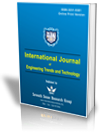Nanotechnology-Assisted Performance, Combustion and Emission Control: A Study on Al₂O₃-Enriched GABME B20 in CI Engines
Nanotechnology-Assisted Performance, Combustion and Emission Control: A Study on Al₂O₃-Enriched GABME B20 in CI Engines |
||
 |
 |
|
| © 2025 by IJETT Journal | ||
| Volume-73 Issue-11 |
||
| Year of Publication : 2025 | ||
| Author : C.S. Abdul Favas, M. Ramarao, S. Prakash, S. Nallusamy | ||
| DOI : 10.14445/22315381/IJETT-V73I11P109 | ||
How to Cite?
C.S. Abdul Favas, M. Ramarao, S. Prakash, S. Nallusamy,"Nanotechnology-Assisted Performance, Combustion and Emission Control: A Study on Al₂O₃-Enriched GABME B20 in CI Engines", International Journal of Engineering Trends and Technology, vol. 73, no. 11, pp.107-118, 2025. Crossref, https://doi.org/10.14445/22315381/IJETT-V73I11P109
Abstract
This research work investigates the green algal biomass induced by Aluminum Oxide (Al₂O₃) nanoparticles on the performance, combustion, and emission characteristics of a diesel engine fueled with neat Diesel and a Green Algae Biofuel Methyl Ester (GABME20) biodiesel blend. The concentration of Al₂O₃ nanoparticles with pure diesel and biodiesel blend, with enhancement in combustion efficiency and emission reduction compared to base diesel. For diesel, the Brake Thermal Efficiency (BTE) increased from 28.2% to 30% which increased to around 6.38%, while BSFC decreased from 0.693 to 0.662 kg/kWh, which decreased to around 4.47%. When Al₂O₃ was added to GABME B20, BTE improved from 27.5% to 29.1% increasing by 3.19% and BSFC was reduced from 0.71 to 0.678 kg/kWh, decreasing around 2.16%. The Heat Release Rate (HRR) reached a maximum of 75 J/°CA for GABME + Al₂O₃ compared to 68 J/°CA for Diesel, indicating enhanced combustion due to improved atomization and catalytic oxidation. Emission analysis revealed significant improvements with Al₂O₃ addition. CO emissions were reduced by 20% for Diesel + Al₂O₃ and 30.86% for GABME + Al₂O₃ relative to Diesel. HC emissions decreased by 11.92% and 8.46% respectively, while NOx increased by 9.57% and 40.43% due to higher in-cylinder temperature and oxygen availability. Smoke opacity showed a marked reduction: 20.31% for Diesel + Al₂O₃, 25% for GABME (B20) and 35.94% for GABME + Al₂O₃ compared to Diesel.
Keywords
Green Algae Biodiesel, Chlorella vulgaris, (Al₂O₃) nanoparticles, Wastewater Derived Fuel.
References
[1] Shahrukh N. Alam et al., “Biodiesel and an Overview of Waste Utilization at the Various Production Stages,” Waste and Biodiesel, pp. 1-16, 2022.
[CrossRef] [Google Scholar] [Publisher Link]
[2] Mohamed F. Al-Dawody et al., “Effect of using Spirulina Algae Methyl Ester on The Performance of a Diesel Engine with Changing Compression Ratio: An Experimental Investigation,” Scientific Reports, vol. 12, no. 1, pp. 1-15, 2022.
[CrossRef] [Google Scholar] [Publisher Link]
[3] S. Aravind et al., “Exposure the Role of Hydrogen with Algae Spirogyra Biodiesel and Fuel-Borne Additive on a Diesel Engine: An Experimental Assessment on Dual Fuel Combustion Mode,” International Journal of Hydrogen Energy, vol. 50, pp. 14522-14535, 2025.
[CrossRef] [Google Scholar] [Publisher Link]
[4] Carmen C. Barrios et al., “Effects of the Addition of Oxygenated Fuels as Additives on Combustion Characteristics and Particle Number and Size Distribution Emissions of a TDI Diesel Engine,” Fuel, vol. 132, pp. 93-100, 2014.
[CrossRef] [Google Scholar] [Publisher Link]
[5] Claus Breuer, “The Influence of Fuel Properties on the Heat Release in DI-Diesel Engines,” Fuel, vol. 74, no. 12, pp. 1767-1771, 1995.
[CrossRef] [Google Scholar] [Publisher Link]
[6] Ekrem Buyukkaya, “Effects of Biodiesel on a DI Diesel Engine Performance, Emission and Combustion Characteristics,” Fuel, vol. 89, no. 10, pp. 3099-3105, 2010.
[CrossRef] [Google Scholar] [Publisher Link]
[7] P.K. Devan, and N.V. Mahalakshmi. “Performance, Emission and Combustion Characteristics of Poon Oil and its Diesel Blends in a DI Diesel Engine,” Fuel, vol. 88, no. 5, pp. 861-867, 2009.
[CrossRef] [Google Scholar] [Publisher Link]
[8] Ge Shengbo et al., “Enhancement of the Combustion, Performance and Emission Characteristics of Spirulina Microalgae Biodiesel Blends using Nanoparticles,” Fuel, vol. 308, 2022.
[CrossRef] [Google Scholar] [Publisher Link]
[9] Himanshi Gupta, and Jitendra N. Gangwar, “A Comprehensive Review of Algal Biodiesel for Compression Ignition Engines: Challenges, Advances and Future Prospects,” Energy & Environment, 2025.
[CrossRef] [Google Scholar] [Publisher Link]
[10] Paul Hellier et al., “An Overview of the Effects of Fuel Molecular Structure on the Combustion and Emissions Characteristics of Compression Ignition Engines,” Proceedings of the Institution of Mechanical Engineers, Part D: Journal of Automobile Engineering, vol. 232, no. 1, pp. 90-105, 2018.
[CrossRef] [Google Scholar] [Publisher Link]
[11] Shehdeh Jodeh et al., “Magnetic Nanocellulose from Olive Industry Solid Waste for the Effective Removal of Methylene Blue from Wastewater,” Environmental Science and Pollution Research, vol. 25, pp. 22060-22074, 2018.
[CrossRef] [Google Scholar] [Publisher Link]
[12] Hyung Gon Kim, and Seung-Hun Choi, “The Characteristics of Biodiesel and Oxygenated Additives in a Compression Ignition Engine,” Journal of Mechanical Science and Technology, vol. 27, pp. 1539-1543, 2013.
[CrossRef] [Google Scholar] [Publisher Link]
[13] M. Saravana Kumar et al. “Experimental Analysis of Lemon Grass Biodiesel (LGB) with Different Exhaust Gas Recirculation,” Materials Today: Proceedings, vol. 33, pp. 876-880, 2020.
[CrossRef] [Google Scholar] [Publisher Link]
[14] Xiaowei Liu et al., “Pilot-Scale Data Provide Enhanced Estimates of the Life Cycle Energy and Emissions Profile of Algae Biofuels Produced Via Hydrothermal Liquefaction,” Bioresource Technology, vol. 148, pp. 163-171, 2013.
[CrossRef] [Google Scholar] [Publisher Link]
[15] Shadman Mahmud et al., “Bioethanol and Biodiesel Blended Fuels-Feasibility Analysis of Biofuel Feedstocks in Bangladesh,” Energy Reports, vol. 8, pp. 1741-1756, 2022.
[CrossRef] [Google Scholar] [Publisher Link]
[16] Mladen Bošnjaković, and Nazaruddin Sinaga, “The Perspective of Large-Scale Production of Algae Biodiesel,” Applied Sciences, vol. 10, no. 22, pp. 1-26, 2020.
[CrossRef] [Google Scholar] [Publisher Link]
[17] Orkun Özener et al., “Effects of Soybean Biodiesel on a DI Diesel Engine Performance, Emission and Combustion Characteristics,” Fuel, vol. 115, pp. 875-883, 2014.
[CrossRef] [Google Scholar] [Publisher Link]
[18] M. Prabhahar et al., “Studies on Pongamia Oil Methyl Ester Fueled Direct Injection Diesel Engine to Increase Efficiency and to Reduce Harmful Emissions,” Advanced Biofuels, pp. 217-245, 2019.
[CrossRef] [Google Scholar] [Publisher Link]
[19] Oladapo Martins Adeniyi, Ulugbek Azimov, and Alexey Burluka “Algae Biofuel: Current Status and Future Applications,” Renewable and Sustainable Energy Reviews, vol. 90, pp. 316-335, 2018.
[CrossRef] [Google Scholar] [Publisher Link]
[20] B. Rajendra Prasath et al., “Analysis of Combustion, Performance and Emission Characteristics of Low Heat Rejection Engine using Biodiesel,” International Journal of Thermal Sciences, vol. 49, no. 12, pp. 2483-2490, 2010.
[CrossRef] [Google Scholar] [Publisher Link]
[21] Ramano K.L, O. Maube, and A.A. Alugongo, “Diesel Engine Emission and Performance Characteristics Fuelled with Jatropha Biodiesel. A Review,” International Journal of Engineering Trends and Technology, vol. 69, no. 6, pp. 79-86, 2021.
[CrossRef] [Publisher Link]
[22] C. Ramesh Kumar, and G. Nagarajan, “Performance and Emission Characteristics of a Low Heat Rejection Spark Ignited Engine Fuelled with E20,” Journal of Mechanical Science and Technology, vol. 26, no. 4, pp. 1241-1250, 2012.
[CrossRef] [Google Scholar] [Publisher Link]
[23] R. Senthil et al., “Performance and Emission Characteristics of a Low Heat Rejection Engine using Nerium Biodiesel and its Blends,” International Journal of Ambient Energy, vol. 38, no. 2, pp. 186-192, 2017.
[CrossRef] [Google Scholar] [Publisher Link]
[24] S. Sivalakshmi, and T. Balusamy, “Effect of Biodiesel and its Blends with Diethyl Ether on the Combustion, Performance and Emissions from a Diesel Engine,” Fuel, vol. 106, pp. 106-110, 2013.
[CrossRef] [Google Scholar] [Publisher Link]
[25] Timothy Vaughn et al., “Ignition Delay of Bio-Ester Fuel Droplets,” No. 2006-01-3302, SAE Technical Paper, 2006.
[CrossRef] [Google Scholar] [Publisher Link]
[26] Harish Venu, and Venkataramanan Madhavan, “Effect of Nano Additives (Titanium and Zirconium Oxides) and Diethyl Ether on Biodiesel-Ethanol Fuelled CI Engine,” Journal of Mechanical Science and Technology, vol. 30, no. 5, pp. 2361-2368, 2016.
[CrossRef] [Google Scholar] [Publisher Link]

